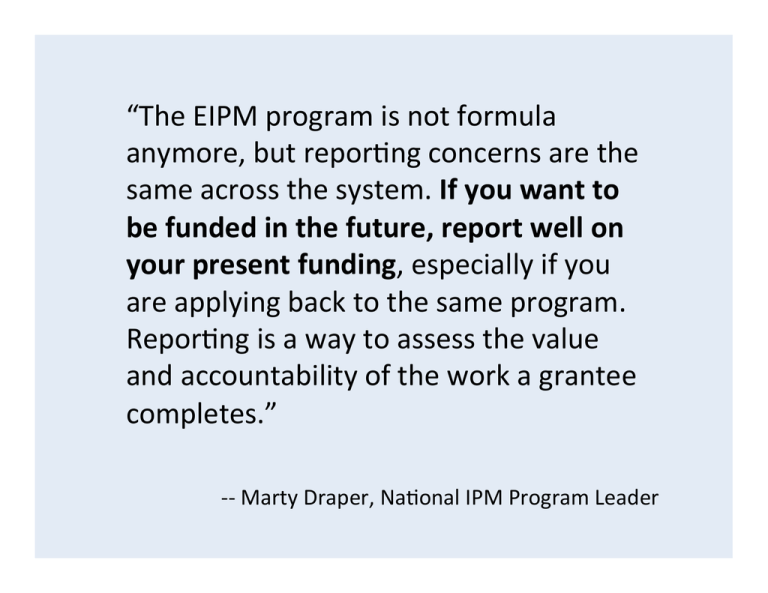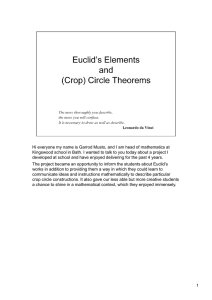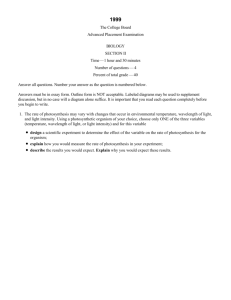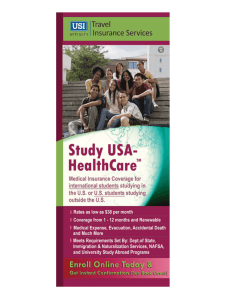Document 10599007
advertisement

“The EIPM program is not formula anymore, but repor:ng concerns are the same across the system. If you want to be funded in the future, report well on your present funding, especially if you are applying back to the same program. Repor:ng is a way to assess the value and accountability of the work a grantee completes.” -­‐-­‐ Marty Draper, Na:onal IPM Program Leader “OHen when I read your CRIS reports I get to the ‘Impacts’ sec:on and I read more about your ac:vi:es and the programs you may have conducted, complete with how many aMended the mee:ng. I would challenge you to rethink what an impact is. Think about outcomes. Think about the, “So what?” ques=on.” -­‐-­‐ Marty Draper, Na:onal IPM Program Leader Writing Meaningful
Outcomes/Impact Statements
± What the NIFA National Program Leaders say
± How to better distinguish between outputs and outcomes
± Making sure your outcomes tell a story of success
National Program Leaders need to see
RXWFRPHVWKDW«
«VWDWHXS-front the issue that was addressed by either (or both) the research and extension
activities.
±
«VKRZSURJUHVVLRQIURPWKHLVVXHWRZKDWZDVGRQHLQUHODWLRQWRWKDWLVVXHDQGZKDWWKHUHVXOWVZHUH
«DUHWKHUHVXOWRIPHDVXUDEOHLQGLFDWRUV
«PHQWLRQKRZWKH\³NQRZ´ZKHWKHUWKHLQGLFDWRUVSURGXFHGPHDVXUDEOHUHVXOWV
±
i.e. what evaluation methodologies were used to generate data for the measures?
«GLVWLQJXLVKFRUUHFWO\EHWZHHQRXWSXWVDQG³DFFRPSOLVKPHQWV´LQWKLVFDVHDQ
accomplishment IS an outcome result).
Distinguishing Between Outputs & Outcomes
Think of an output as a PHDVXUDEOH³SURGXFW´ that
results from a certain activity, whereas an outcome is
change in something.
An output is usually tangible ± \RXFDQVHHWKH³SURGXFW´
± Examples: websites, publications, patents, trainees
Remember, producing outputs leads to outcomes.
± You can train people to be able to educate children on
healthy eating, but just having trained them (the output)
GRHVQ¶WQHFHVVDULO\UHVXOWLQFKLOGUHQSUDFWLFLQJKHDOWK\
eating (the outcome).
Examples of Outputs
Notice how each output in
the list on the right is
indicated E\³QXPEHURI´
instead of a measurable
change in something.
Think about how you can
³VHH´WKHSURGXFWVRI
those output statements
(tangible numbers of
things).
What makes an outcome an outcome?
2XWFRPHVDUH³VWRULHV´WKDWGHPRQVWUDWHDFKDQJH
in something.
NIFA needs you to tell your story in 6-10 lines.
This is done by PDNLQJVXUH\RXU³VWRU\´KLWVWKUHH
main points:
1. Issues
2. What was/has been done
3. Results
How to Define/Demonstrate Change
7KHUHDUHWKUHHW\SHVRI³FKDQJH´WKDW1,)$
uses to classify outcomes:
± Change in Knowledge: Occurs when a participant (scientist,
trainee, citizen, etc.) learns or becomes aware.
± Change in Action: Occurs when there is a change in behavior
or the participants act upon what they have learned (adoption
of techniques and methods or a change in practice).
± Change in Condition: Occurs when a societal condition is
changed due to a participant's action.
-­‐-­‐-­‐World-­‐-­‐-­‐ -­‐-­‐-­‐People-­‐-­‐-­‐ What is Learned What is Done What is Changed How we achieve outcomes What we evaluate Example
The screenshot below shows a particular software program used by NIFA
to collect data on each of the three areas that compose an good outcome
story: issue, what has been done, and results. Regardless of whether
software is used or you are writing from scratch on a word document,
WKHVHWKUHHDUHDVVKRXOGDOZD\VEHDGGUHVVHGZLWKWKH³FKDQJH´EHLQJ
GHVFULEHGLQWKH³UHVXOWV´VHFWLRQ
Documen;ng Outcomes: 3 steps 1. Evalua;on Objec;ve: – What change do you want to document? 2. Measurement Indicator: – What data will you use to document change? What will you measure? 3. Methodology: – How will you collect the data? How will you analyze the data? IPM Example (WRIPM grant) 1. Objec;ve 1: To measure changes in pest manager knowledge of natural enemies (I.D.) & their role in whitefly management. 2. Measurement Indicator: Ability to iden;fy (a) natural enemies and (b) their role in whitefly management. (% correct) 3. Method: Audience response survey Example
The screenshot below shows a particular software program used by NIFA
to collect data on each of the three areas that compose an good outcome
story: issue, what has been done, and results. Regardless of whether
software is used or you are writing from scratch on a word document,
WKHVHWKUHHDUHDVVKRXOGDOZD\VEHDGGUHVVHGZLWKWKH³FKDQJH´EHLQJ
GHVFULEHGLQWKH³UHVXOWV´VHFWLRQ
Telling your outcome story (cont.)
0DNHVXUH\RXU³VWRU\´IORZVE\FRQQHFWLQJWKHVH
WKUHH³DUHDV´
,QWKH³ZKDWKDVEHHQGRQHVHFWLRQ´\RXVKRXOG
make sure to mention what methodologies were
used to collect/measure data.
The results of the measured data that show a
change in knowledge, action, or condition should
EHSDUWRIWKH³UHVXOWV´VHFWLRQ
Example: Measurable Indicators for
Collecting Data to Show Change
The four outcome measures/indicators in the blue box are all associated with the same activity; the results of
this activity (i.e. the data from the indicators) should be combined in a few sentences to show the public value
of the funding of that activity. This is done by taking the four percentages measured in the indicators and
VWDWLQJWKHPDVLQGLFDWRUVIRUZKLFKGDWDZHUHFROOHFWHGLQWKH³ZKDWKDVEHHQGRQH´VHFWLRQRIWKHRXWFRPH
VWRU\7KH³UHVXOWV´VHFWLRQVKRXOGWKHQPDNHDEURDGVWDWHPHQW± 1-2 sentences ± that combines the four
GDWDSRLQWVLH³2XUGDWDVKRZWKDWWKH\RXWKZKRSDUWLFLSDWHGLQ&///HVVRQVJDLQHGFRQVLGHUDEOHLQFUHDVHV
in their knowledge of healthy food choices. The data also show that this knowledge lead to those youth
reporting major increases in making healthy food choices and participating in other activities that contibute to
KHDOWK\OLIHVW\OHV´
³5HVXOWV´VKRXOGVKRZpublic value
What do we mean by public value?
Ask yourself: Why is the program important to constituents?
([DPSOH2QHRXWFRPHPHDVXUHLQWKLV\HDU¶V$5ZDVWKH
³3HUFHQWDJHRI\RXWKLQFUHDVLQJNQRZOHGJHDQGVNLOOVLQ\RXWK
HQWUHSUHQHXUVKLS´
±
In the qualitative description, the state described one teen venture earning
$138.00 selling a product to restaurants.
±
This is great, but may not be significant.
To illustrate significance, here is a revised example:
±
As a result of the Youth Entrepreneurship Program and teens becoming
contributing young adults to society, X teens in the Superior Court Juvenile
Program were prevented from incarceration, which saved X dollars in annual cost
in the juvenile system.
±
This demonstrates public value and highlights for decision makers why
funding this initiative is important.
:KHQZULWLQJRXWFRPHVRUUHSRUWLQJ³LPSDFWVWDWHPHQWV´
for any project or program, ask yourself:
Have I listed at least one or two quantitative outcome
measures and are they actually measurable? If they are, do we
have the evaluation tools in place to perform the
measurement?
Do the qualitative descriptions in the three areas (issues, done,
results) demonstrate impact/public value?
± Do they describe a clear progression of what the issue was, what was
done, and what the results were?
± Is there at least ONE sentence that a reader can hone in on and say
³7+$7LVZK\WKLVIXQGLQJLVLPSRUWDQW´LQWKH³UHVXOWV´ER[)?
Overall, does the ³VWRU\´LWVHOIeffectively combine quantitative
measures with qualitative description?
± An impact statement should not just be a listing of data, survey results,
outputs, etc.
When writing a qualitative description:
Be direct and to the point - NIFA encourages brevity!
'RQ¶WPDNHODQJXDJHRYHUO\IRUPDORUVFLHQWLILFWRWKH
point of being obscure.
± Remember that we use your outcome statements for many
purposes and that they reach many types of audiences, many
of whom do NOT have scientific backgrounds!
Write your outcome story as if it will need to grab
SHRSOH¶VDWWHQWLRQRQWKHIURQWSDJHRIDQHZVSDSHU
make it clear that THIS story has an IMPACT on
people/the community/the state.
How to form the best qualitative description:
Make sure you are describing a clear progression between the
three parts of an outcome statement/paragraph:
1.
What was/is the issue problem in your state/region/community, etc.?
Or, if there is not a problem per se, what is the overall topic of the research/extension
activities, and why does it matter to the given community?
2.
What was done to address that issue or in relation to the topic of
#1?
3.
What changes in knowledge, action(s), or condition(s) occurred as a
result of #2 and how does this help the larger community?
Remember to include specific numbers that capture the
positive changes.
±
We love to see figures for percentage increases, dollars saved,
dollars earned, value increases, etc.
Good progression makes for a
stronger story/impact.
1. General Topic
2. Specific Action Taken to address the general topic
3. Results of the action are reported in specific
quantitative terms and at least one specific
TXDOLWDWLYHVHQWHQFH³7KLVUHVHDUFKZLOOKDYH
ODVWLQJHIIHFWVRQ«´LQRUGHUWRVKRZWKHSXEOLF
value.
Example of Lack of Progression/Impact
In one qualitative statement, it was stated:
1. Helping youth become involved in their communities increases
perception of self-worth and leads to healthier choices.
2. High school students were taught a class on invasive species
and then volunteered to remove invasive species from public
parklands.
.
3. 32 acres of parkland were cleared of invasive species.
A NIFA National Program Leader
Commented:
Although it is commendable that invasive species were
removed from 32 acres of parkland, what issue does that
address, and what benefit does that have for the parklands
and environment?
There is no connection between the issue, activity, and
results. Will the people trained continue to use the
information to change something in particular? Is invasive
species a problem (economic in nature) in the current area?
If the impact of this work on the environment could be
UHSRUWHGWKLVZRXOGEHDVROLGRXWFRPHVWDWHPHQW´
Example of Good Progression/Impact
General
Specific
Related Action
Report of what
the Action did
± here,
increase in
income and
ROI
Issue:
During the past five years, Colorado wheat farmers have planted an average
of 20% of their fields to newly released and improved wheat varieties. This
is a faster adoption rate of improved wheat varieties than for growers from
comparable states.
What has been done:
The Colorado State University (CSU) Extension Wheat Improvement Work
Team provided 18% of the total investment in developing and promoting CSU
wheat varieties.
Results:
Plantings of improved wheat varieties increased Colorado farmers' farm gate
income by $12,840,000 in 2012. Extension's share (18%) of this impact for the
Colorado wheat industry is $2,311,000, or about $13.70 returned for each $1.00
invested.
Summary on Writing Better Outcomes
Make sure your outcomes are results that are measured by data that
show change(s) in knowledge, action, and/or condition.
± 5HPHPEHUWKDWRXWSXWVDUH³SURGXFWV´EXWQRWQHFHVVDULO\FKDQJHV
Combine multiple measures to create one strong qualitative
statement.
Qualitative statements should be concise and show progression from
the issue, to what was done, to what the results were.
At least ONE SENTENCE in a good qualitative statement should
highlight the public value of the activity supported by the funding.
!"##"$%&'()%*%+,-.#%/.0"1,#-"$%/.2,3.4%!"4#45%6"44.4%7$2%/-484%9":%*:-;"$7<4%!"##"$%
=:">.:4%%
!"#$%&'#()*+,*-&#.+"/*0+11%2%*+,*-2&#341(4&%*/"5*6#,%*73#%"3%'*89::*;<=/3(*>%=+&(*%
!
&44,.%%%
?4&#"2*(@%*<#5AB9'C*#"'%3(#3#5%*/==1#3/(#+"'*#"*3+((+"*()=#3/11)*/33+4"(%5*,+&*/D+4(*@/1,*
+,*/11*#"'%3(#3#5%*4'%*#"*(@%*!"#(%5*7(/(%'E*;"*:BBFC*"%/&1)*:99*=%&3%"(*+,*-&#.+"/G'*3+((+"*
/3&%/2%*H/'*'=&/)%5*<41(#=1%*(#<%'*,+&*=#"I*D+11H+&<C*6)24'*D42C*/"5*'#1$%&1%/,*
H@#(%,1)E*J%H*(%3@"+1+2#%'*@/$%*%"/D1%5*3+((+"*2&+H%&'*(+*&%543%*(@%#&*'=&/)*
/==1#3/(#+"'*'#2"#,#3/"(1)*H@#1%*/3@#%$#"2*/<+"2*@#2@%'(*3+((+"*)#%15'*H+&15H#5%E*K%@#"5*
+"1)*0/1#,+&"#/*/"5*-4'(&/1#/C*-&#.+"/*"+H*=&+543%'*(@%*@#2@%'(A)#%15#"2*3+((+"*#"*(@%*
H+&15C*"%/&1)*:CF99*=+4"5'*+,*,#D%&*=%&*/3&%C*,/&*%L3%%5#"2*(@%*!E7E*"/(#+"/1*/$%&/2%*+,*
/D+4(*M99*=+4"5'*=%&*/3&%E*N@%'%*(%3@"+1+2#%'*/1'+*@%1=*2&+H%&'*#<=1%<%"(*<+&%*
%3+1+2#3/11)AD/'%5C*'4'(/#"/D1%*;OP*=&+2&/<'*/"5*D%3+<%*1%''*5%=%"5%"(*+"*D&+/51)*
(+L#3*#"'%3(#3#5%'E**
*
?@7#%@74%A..$%2"$.%%%
-"*#"(%2&/(%5*=%'(*</"/2%<%"(*=&+2&/<*Q;OPR*%'(/D1#'@%5*#"*-&#.+"/*#"*:BBSC*&%,#"%5*
#"*899S*/"5*3+"(#"4%5*(@&+42@*(+5/)*4'%'*#"'%3(*2&+H(@*&%241/(+&'*Q;T>'U%,,%3(#$%*
/2/#"'(*H@#(%,1#%'RC*(&/"'2%"#3*3+((+"*QH#(@*K(U!"#$%%&'()*&+$,-$.,'$'U%,,%3(#$%*/2/#"'(*
=#"I*D+11H+&<'RC*/"5*/*&%543%5A&#'I*,%%5#"2*#"@#D#(+&*Q%,,%3(#$%*/2/#"'(*6)24'*D42'RE*7/,%*
,+&*@4</"'C*(@%'%*(++1'*I#11*+"1)*(@%#&*(/&2%(*=%'('C*/11+H#"2*"/(4&/1*=&+3%''%'*(+*=1/)*/*
1/&2%&*&+1%*#"*(@%*</"/2%<%"(*+,*/11*+(@%&*=%'(*#"'%3('E*T&+H%&'*@/$%*D%%"*(/42@(*(+*
5%=1+)*,411)*'%1%3(#$%*</(%&#/1'*,#&'(*/"5*H@%"%$%&*=+''#D1%E*N@%*!-*0+11%2%*+,*
-2&#341(4&%*/"5*6#,%*73#%"3%'*#"#(#/(%5*(@%*=&+2&/<*#"*3+11/D+&/(#+"*H#(@*2&+H%&'C*!7?-C*
-&#.+"/*?%=/&(<%"(*+,*-2&#341(4&%C*-&#.+"/*0+((+"*T&+H%&'G*-''+3#/(#+"C*0+((+"*
;"3+&=+&/(%5C*-&#.+"/*0+((+"*>%'%/&3@*V*O&+(%3(#+"*0+4"3#1C*#"54'(&)*/"5*+(@%&'E***
*
&BC73#%%%
N@%*,411)*#<=1%<%"(%5C*3+11/D+&/(#$%*3+((+"*;OP*=&+2&/<*@/'*&%2#'(%&%5*'#2"#,#3/"(*
2/#"'*'#"3%*#('*#"3%=(#+"*#"*:BBSW**
*
• 7(/(%H#5%*/$%&/2%'*,+&*3+((+"*#"'%3(#3#5%*4'%*=/((%&"'*#"*-&#.+"/*,&+<*:BXB*
(@&+42@*89:9*'@+H*(@/(*#"'%3(#3#5%*4'%*+"*3+((+"*,+&*/11*#"'%3('*3+<D#"%5U
#"3145#"2*H@#(%,1#%'C*=#"I*D+11H+&<C*6)24'*D42*/"5*+(@%&'*&%/3@%5*/*Y8A)%/&*1+H*
+$%&*(@%*1/'(*F*)%/&'C*H@#1%*/1'+*&%543#"2*3+'('*(+*/11A(#<%*1+H'E*N@%*%'(#</(%5*
34<41/(#$%*'/$#"2'*#"*3+"(&+1*3+'('*/"5*)#%15*Q,&+<*&%543%5*1+''%'*(+*#"'%3('R*
,&+<*:BBS*(@&+42@*89:9*H/'*<+&%*(@/"*Z88Y*<#11#+"E*7+4&3%W*0+((+"*O%'(*
6+''%'*Q0O6RE*
*
• T&+H%&'*/==1#%5*[E:F*=+4"5'*+,*/3(#$%*#"'%3(#3#5%*#"2&%5#%"(*=%&*/3&%*+,*3+((+"*
#"*:BBFE*;"*899B*/"5*/1'+*#"*89:9*(@%*/<+4"(*+,*/3(#$%*#"2&%5#%"(*/==1#%5*=%&*
/3&%*H/'*&%543%5*D)*YESS*=+4"5'C*+&*MMEY*=%&3%"(C*(+*\4'(*9E[M*=+4"5'*=%&*/3&%E*
N@#'*#'*(@%*%]4#$/1%"(*+,*/==1)#"2*1%''*(@/"*/*3/"*+,*'+5/*+"*/"*/&%/*(@%*'#.%*+,*/*
,++(D/11*,#%15*\4'(*+"3%*+$%&*(@%*3+((+"*'%/'+"*QP/&3@*(+*^3(+D%&RE*7+4&3%W*0O6C*
J/(#+"/1*-2&#341(4&/1*7(/(#'(#3'*7%&$#3%E*
CoUon Impacts: The Issue • During the mid-­‐90s, insec;cide applica;ons in coUon typically accounted for about half of all insec;cide use in the United States. CoUon Impacts: What was done • Research on new technologies & integra;on into IPM programs • Outreach to train pest managers • Surveys on pest problems, management prac;ces and costs – Annual statewide pes;cide use CoUon Impacts: Results • Total insec;cide sprays reduced by 85% • Equivalent of applying less than a can of soda on an area the size of a football field • The percentage of coUon acres never sprayed for insects in 2010 was 29.3% How do we get there from here?



